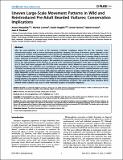Por favor, use este identificador para citar o enlazar a este item:
http://hdl.handle.net/10261/78564COMPARTIR / EXPORTAR:
 SHARE SHARE
 CORE
BASE CORE
BASE
|
|
| Visualizar otros formatos: MARC | Dublin Core | RDF | ORE | MODS | METS | DIDL | DATACITE | |

| Título: | Uneven large-scale movement patterns in wild and reintroduced pre-adult bearded vultures: Conservation implications |
Autor: | Margalida, Antoni CSIC ORCID ; Carrete, Martina CSIC ORCID; Hegglin, Daniel; Serrano, David CSIC ORCID; Arenas, Rafael; Donázar, José A. CSIC ORCID | Fecha de publicación: | 2013 | Editor: | Public Library of Science | Citación: | PLoS ONE 8(6): e65857 (2013) | Resumen: | After the quasi-extinction of much of the European vertebrate megafauna during the last few centuries, many reintroduction projects seek to restore decimated populations. However, the future of numerous species depends on the management scenarios of metapopulations where the flow of individuals can be critical to ensure their viability. This is the case of the bearded vulture Gypaetus barbatus, an Old World, large body-sized and long-lived scavenger living in mountain ranges. Although persecution in Western Europe restrained it to the Pyrenees, the species is nowadays present in other mountains thanks to reintroduction projects. We examined the movement patterns of pre-adult non-breeding individuals born in the wild population of the Pyrenees (n = 9) and in the reintroduced populations of the Alps (n = 24) and Andalusia (n = 13). Most birds were equipped with GPS-GSM radio transmitters, which allowed accurate determination of individual dispersal patterns. Two estimators were considered: i) step length (i.e., the distance travelled per day by each individual, calculated considering only successive days); and ii) total dispersal distance (i.e., the distance travelled between each mean daily location and the point of release). Both dispersal estimators showed a positive relationship with age but were also highly dependent on the source population, birds in Andalusia and Alps moving farther than in Pyrenees. Future research should confirm if differences in dispersal distances are the rule, in which case the dynamics of future populations would be strongly influenced. In summary, our findings highlight that inter-population differences can affect the flow of individuals among patches (a key aspect to ensure the viability of the European metapopulation of the endangered bearded vulture), and thus should be taken into account when planning reintroduction programs. This result also raises questions about whether similar scenarios may occur in other restoration projects of European megafauna | Versión del editor: | http://dx.doi.org/10.1371/journal.pone.0065857 | URI: | http://hdl.handle.net/10261/78564 | DOI: | 10.1371/journal.pone.0065857 | E-ISSN: | 1932-6203 |
| Aparece en las colecciones: | (EBD) Artículos (IREC) Artículos |
Ficheros en este ítem:
| Fichero | Descripción | Tamaño | Formato | |
|---|---|---|---|---|
| journal.pone.0065857.pdf | 4,26 MB | Adobe PDF |  Visualizar/Abrir |
CORE Recommender
PubMed Central
Citations
19
checked on 04-abr-2024
SCOPUSTM
Citations
59
checked on 15-abr-2024
WEB OF SCIENCETM
Citations
52
checked on 25-feb-2024
Page view(s)
304
checked on 22-abr-2024
Download(s)
170
checked on 22-abr-2024
Google ScholarTM
Check
Altmetric
Altmetric
Artículos relacionados:
NOTA: Los ítems de Digital.CSIC están protegidos por copyright, con todos los derechos reservados, a menos que se indique lo contrario.
